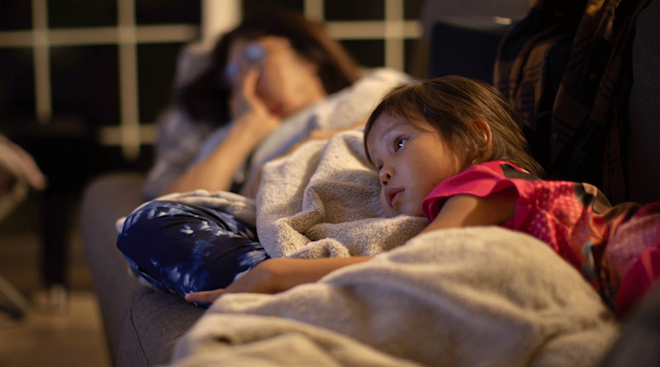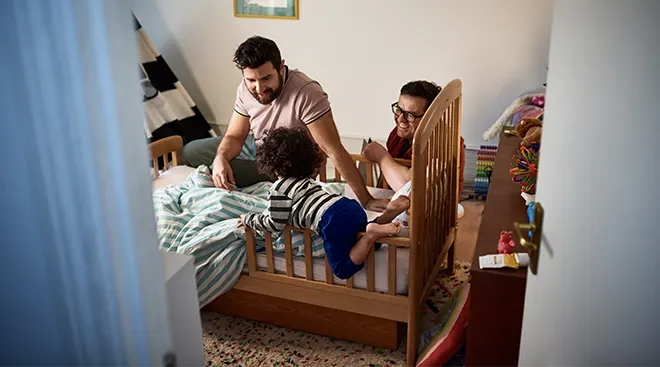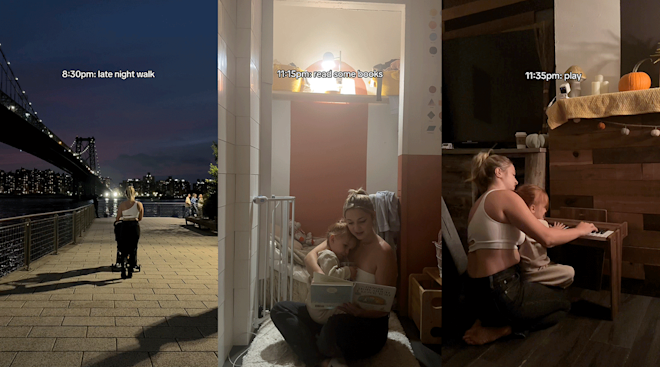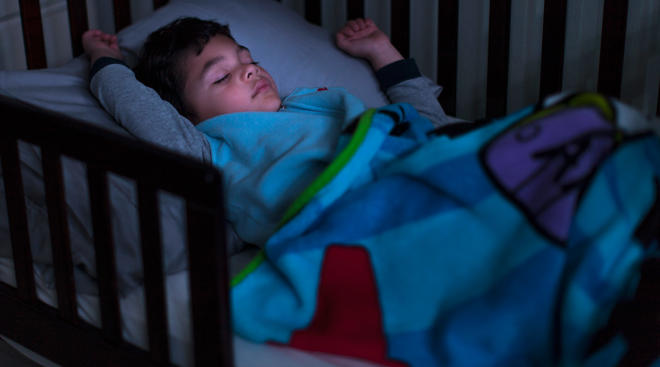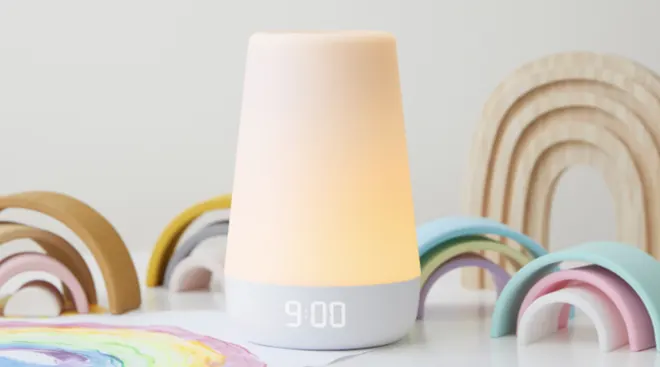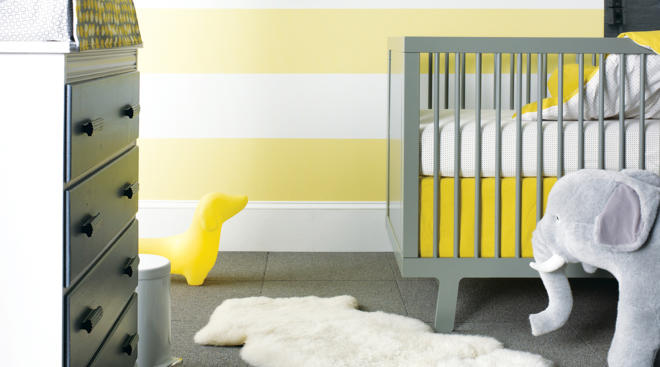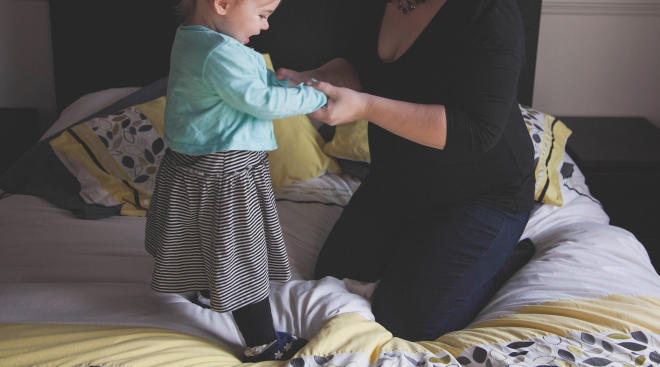How to Get a Toddler to Sleep (and How Much Sleep Do They Need Anyway?)
Putting baby to bed was hard enough. But if your toddler won’t sleep? That’s a whole different ball game. Your little one might draw out bedtime (“one more story!”), refuse naps or wake up for the day at an hour when some college kids are just coming home.
“Adequate sleep is essential for your child’s healthy development and behavior,” says Eboni Hollier, MD, FAAP, a Houston-based pediatrician. “Children who don’t get enough quality sleep have more challenges regulating their behavior. Inadequate sleep may result in an irritable or cranky mood, excessive tantrums and increased aggressive behavior, and may also affect learning, attention and concentration.”
Wondering how to get a toddler to sleep—and how much sleep a toddler actually needs? Read on for expert advice on bedtime, naptime and more.
While some toddlers need a bit more or less sleep than others, there are a few general guidelines by age to keep in mind. “In general, children between the ages of 12 and 36 months require an average of 12 to 14 hours of sleep per day,” Hollier says. “This often consists of about 11 hours of sleep at night and one to three hours of daytime naps. Keep in mind that children who have shorter daytime naps or who don’t nap during the day will likely sleep longer during the night.”
Toddler sleep does tend to consolidate as kids grow, Hollier adds. “The amount of daytime sleep a child gets decreases significantly over the child’s first three years of life, because toddlers often sleep more deeply at night than infants do,” she explains. “While most toddlers nap at least once per day, this may vary depending on several factors, including familial cultural expectations, daycare schedule, parents’ developmental expectations for the child, parental work schedule and the child’s own need for sleep.”
How much sleep does a one-year-old need?
One-year-olds generally need 11 to 14 hours of sleep per 24 hours (including naps), according to the American Academy of Sleep Medicine (AASM).
How much sleep does a 2-year-old need?
Two-year-olds should also be getting around 11 to 14 hours of sleep per day, says the AASM. Again, keep in mind that some toddlers have lower sleep needs than others, in which case “parents will likely find pre-made schedules, wake windows or tracking naps very frustrating and unhelpful, and should go by ‘sleepy cues,’” advises Rachael Shepard-Ohta, MEd, a San Francisco-based baby and toddler sleep consultant and owner of Hey, Sleepy Baby.
How much sleep does a 3-year-old need?
Once toddlers get to preschool age, the AASM recommends about 10 to 13 hours per day, including a nap—if they’re still taking it. Shepard-Ohta says most kids are ready to drop their nap between ages 3 and 4-and-a-half, although this is also highly individual.
How much sleep does a 4-year-old need?
Four-year-olds should also sleep for around 10 to 13 hours per day, says the AASM.
How much sleep does a 5-year-old need?
Between 10 to 13 hours of sleep per 24 hours is optimal for a 5-year-old, according to the AASM.
Toddler naps are tricky, since most toddlers still do need to nap but become increasingly averse to napping. Is your toddler refusing to nap? This is often due to FOMO, notes Shepard-Ohta—after all, there are so many more exciting things to do in toddler world. Read on for how to make naptime just a bit easier.
Toddler nap schedule
When considering a toddler nap schedule, first keep in mind how many naps they need per day. Most toddlers drop their second nap between 12 and 18 months. “At 12 months, toddlers typically nap twice per day,” Hollier says. “By 18 months, most children only nap once a day.”
While the timing and length of naps can vary by child—and depends on what’s going on at home, or their schedule at daycare or preschool—the general trend is that toddlers will take one nap in the middle of the day, often after lunch, says Hannah Clapham, a London-based holistic baby and toddler sleep consultant and owner of Little Nest Sleep.
“Having consistent timings for mealtimes and naps, as well as rituals around sleep, helps keep this predictable,” Clapham says. “So for example, you might have a pattern of doing lunch and then a short pre-nap routine such as reading a story, nursing and putting a sleep sack on in their bedroom. This ritual gives a toddler some time to wind down for sleep.”
How long should a toddler nap?
How long a toddler naps depends on the child, but anywhere between one and three hours is common when they’re taking one nap a day, says Shepard-Ohta. Don’t try to “force” a nap: “If it’s shorter than this and they wake up refreshed and are otherwise healthy and thriving, don’t worry about it!” she says.
What to do if your toddler is refusing to nap
A toddler refusing to nap is very developmentally normal, say experts. “Sometimes sleep resistance is about a toddler having better things to do than snooze!” says Clapham. “Life is fun and exciting—why sleep if you can power on through and keep playing?” That said, sometimes a toddler is refusing a nap but clearly needs it. Here are a few things you can do if your toddler won’t nap:
- Make sure they’re actually tired. Sometimes parents get too caught up in following a schedule and forget that their child simply might not be tired enough to sleep, notes Shepard-Ohta. Tire them out by making sure they’re getting plenty of sensory stimulation throughout their day, including time outside and exercise, she suggests.
- Take time to connect. “I recommend making some time for intentional connection before naptime to fill your child’s ‘connection cup,’” says Shepard-Ohta. Clapham notes that it’s possible your toddler is going through a stage of separation anxiety and they won’t nap because they want to hang out with you. “Maybe they’re testing the boundaries around daily routines and limits, and are exploring what happens if they say ‘no’ to sleep,” Clapham adds. These behaviors might be frustrating, but they’re completely normal.
- Get moving. Take “the path of least resistance” when your toddler won’t nap, advises Claire Fair, a Sydney-based certified infant and child holistic sleep consultant and owner of The Gentle Sleep Coach. The movement of their stroller—or going on a drive—could be just what your little one needs to nod off peacefully, she says.
- Don’t get too attached to a schedule. While following a routine is helpful, you don’t need to watch the clock if you don’t find it helpful. “Schedules for kids this little are just a moving target—they rarely stay the same for very long!” says Shepard-Ohta.
When does a toddler stop napping?
Again, most toddlers are ready to call it quits on naptime between ages 3 and 4-and-a-half, according to Shepard-Ohta. “If you’re experiencing really long bedtimes, frequent night wakings or early-morning wakeups with your toddler, that’s when I’d experiment with shortening the nap,” she advises.
However, if your toddler doesn’t need a lot of sleep in general, they might drop their nap earlier. “If you have a low-sleep-needs toddler, you might find they drop their nap much earlier than their peers, perhaps between 18 and 24 months,” says Clapham. “It’s usually a process, though, with sleep resistance being stage one and the occasional skipped nap [becoming] a regularly skipped nap.”
If your toddler won’t sleep, you’re certainly not alone. At the end of a long day, it can be tough to deal with a drawn-out bedtime—you’ve got enough on your plate already. Ahead, experts share their strategies for how to get a toddler to sleep.
- Make sure there’s enough sleep pressure. When we’ve been awake for too long, our sleep pressure (aka the homeostatic sleep drive) goes up and tells us it’s time to go to sleep. It’s the same with toddlers. “Your child has to be tired enough—without being overtired—to go to bed,” says Shepard-Ohta.
- Offer lots of connection. Just like naps—but even more so—bedtime is a time when toddlers might experience separation anxiety and need more connection. “We have to think about bedtime as a major separation for a child—the biggest one of their day!” says Shepard-Ohta. “We’re asking them to spend 10 to 12 hours apart from us, which feels like a really big deal for them. It’s almost no wonder they’d fight it.” She says it’s important that your child feels safe and secure in their connection with you before asking them to separate, which can include strategies like practicing short partings and using a lovey or other attachment object.
- Slow down the bedtime routine. You might have an established bedtime routine, but sometimes it helps not to rush it, says Fair. She adds that visual cues like a bedtime routine chart can also help with the transition to sleep, and make the process fun.
- Increase the sensory input. If your toddler is bouncing off the walls during bedtime, they might be seeking sensory input, says Fair. Meeting their sensory needs before bed can help them sleep and be a great form of connection. Keeping in mind that all children have different sensory needs, she recommends “introducing some rough-and-tumble play—couch jumps, hall runs, family dance parties, play wrestling” and more.
Once you’ve conquered bedtime (good job!), it might be time to start thinking about some other common sleep challenges that your toddler is experiencing. Whether your toddler wakes up crying or pops out of bed at the crack of dawn, experts have suggestions and solutions.
Why does my toddler wake up crying?
If your toddler wakes up crying in the middle of the night, you can “play detective” to see if it might be their two-year molars coming in, says Shepard-Ohta. Teething can often cause disrupted sleep. Another reason your toddler wakes up crying could be night terrors. Occasionally, toddlers just need some reassurance—which is totally normal. Once you figure out why your toddler wakes up crying, you can come up with a plan for what to do.
My toddler won’t sleep alone
This is another instance where separation anxiety plays a role. “To [encourage] your toddler to sleep in their own bed, it helps to have little pieces of you in the room,” says Shepard-Ohta. “Maybe you let them have a special photo to put under their pillow, or you give them a lovey that smells like you. You might also help them feel safe and secure in their room by using a mantra: ‘My bed is safe and cozy,’ ‘Mommy is right nearby.’” Fair says that using a floor bed can help toddlers with settling to sleep. “Removing the barrier of the cot and allowing some autonomy can lead to less resistance at bedtime, and being able to lay with your toddler to support them to sleep can also help with settling and resettling,” she says.
My toddler isn’t sleeping through the night
The first thing to do is recognize that this is normal, says Fair, citing a 2020 study that found that toddlers who were between 12 and 24 months woke up on average one to two times a night. Above all, it’s important to surround yourself with support during this period. But if your child is waking up multiple times a night and it takes a long time for them to resettle, it might be worth a deeper look, Shepard-Ohta writes on her blog. Don’t hesitate to reach out to your doctor if the waking seems unusual. And if there are no medical issues and you think you might be ready to try night weaning, a sleep consultant can help you decide which path is right for you.
My toddler wakes up too early
Yawn. If your toddler wakes up too early, make sure to avoid turning on lights or screens so you don’t reinforce the wake, says Shepard-Ohta. “Try to keep things dark and calm until your ideal wakeup time,” she suggests. She also says in her blog that some babies and toddlers only need 9 or 10 hours of overnight sleep. If they’re going to bed early, it’s no surprise they’re partying at 5 a.m. Consider other factors: Is it too cold? Are they hungry after sleeping a long stretch? If it’s too bright in their sleep space, you might consider adding blackout curtains.
At the end of the day, your toddler’s sleep is likely to improve as they get older. For now, keep in mind these expert strategies—and know that if your toddler doesn’t love to sleep, you’re far from alone.
Please note: The Bump and the materials and information it contains are not intended to, and do not constitute, medical or other health advice or diagnosis and should not be used as such. You should always consult with a qualified physician or health professional about your specific circumstances.
Plus, more from The Bump:
Hannah Clapham, is a London-based holistic baby and toddler sleep consultant and owner of Little Nest Sleep. She’s a Level 4 OCN-certified sleep coach and Level 3 OCN-certified in infant reflux and colic. She has also completed the UK’s Association of Breastfeeding Mothers’ breastfeeding foundation course.
Claire Fair, is a Sydney-based OCN Level 6 certified holistic sleep coach and owner of The Gentle Sleep Coach.
Eboni Hollier, MD, FAAP, is a Houston-based developmental and behavioral pediatrician. She’s also a speaker, consultant and author. She earned her medical degree from the University of Mississippi School of Medicine.
Rachael Shepard-Ohta, MEd, is a San Francisco-based baby and toddler sleep consultant and owner of Hey, Sleepy Baby. She is also an elementary education specialist.
American Academy of Sleep Medicine, Child Sleep Duration Health Advisory, April 2016
Sleep Foundation, Sleep Drive and Your Body Clock, August 2023
Sleep Medicine, Normal Sleep Development in Infants: Findings from Two Large Birth Cohorts, May 2020
Learn how we ensure the accuracy of our content through our editorial and medical review process.
Navigate forward to interact with the calendar and select a date. Press the question mark key to get the keyboard shortcuts for changing dates.

































